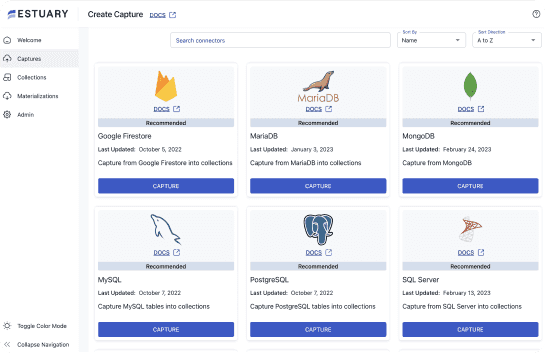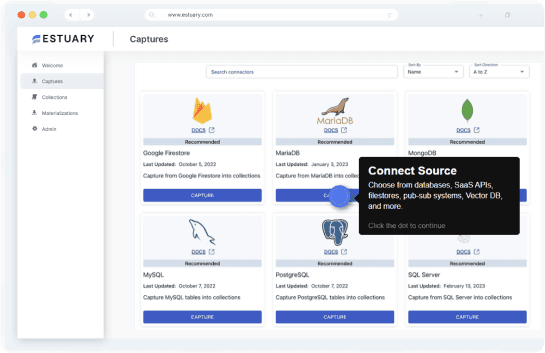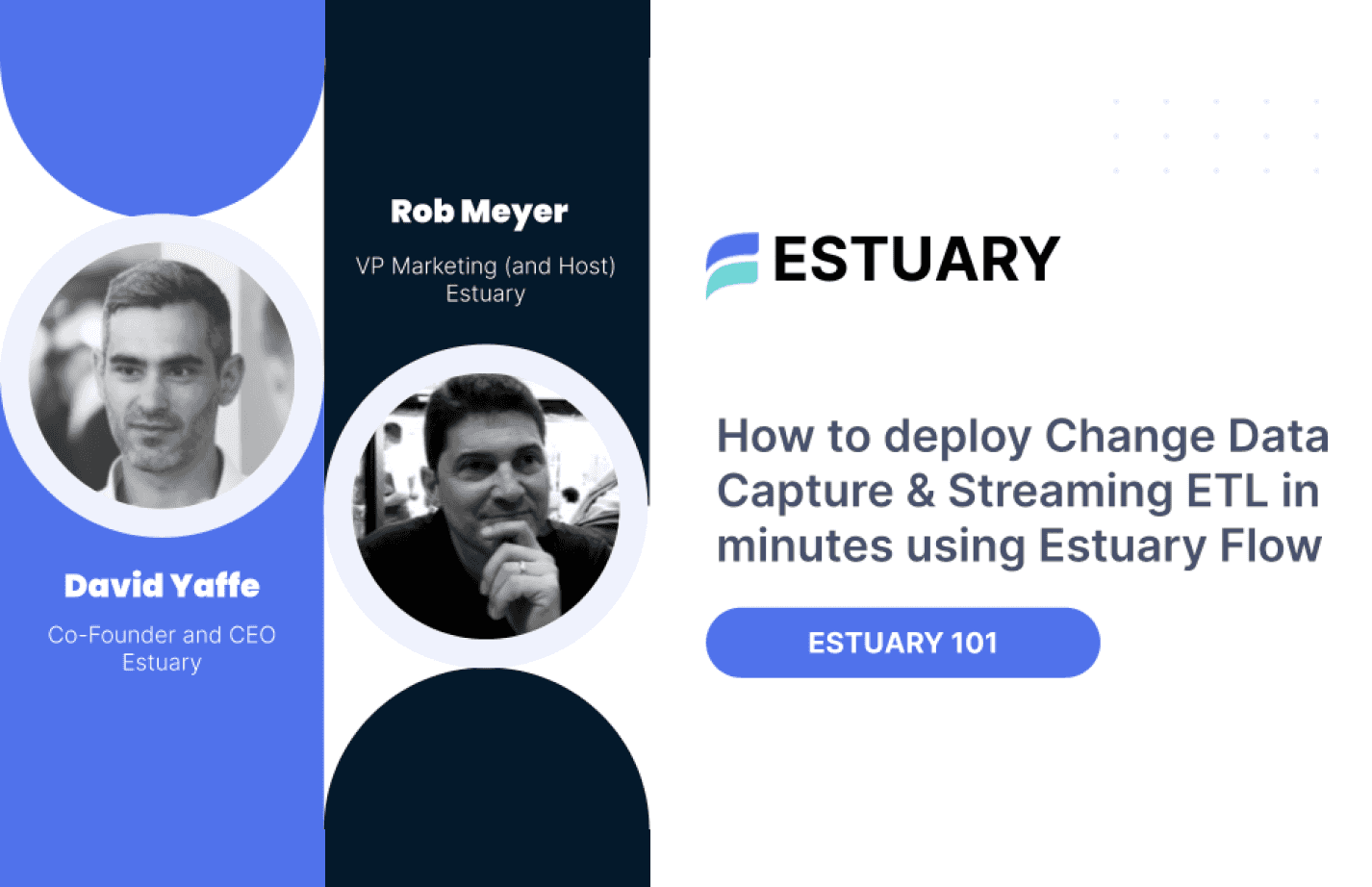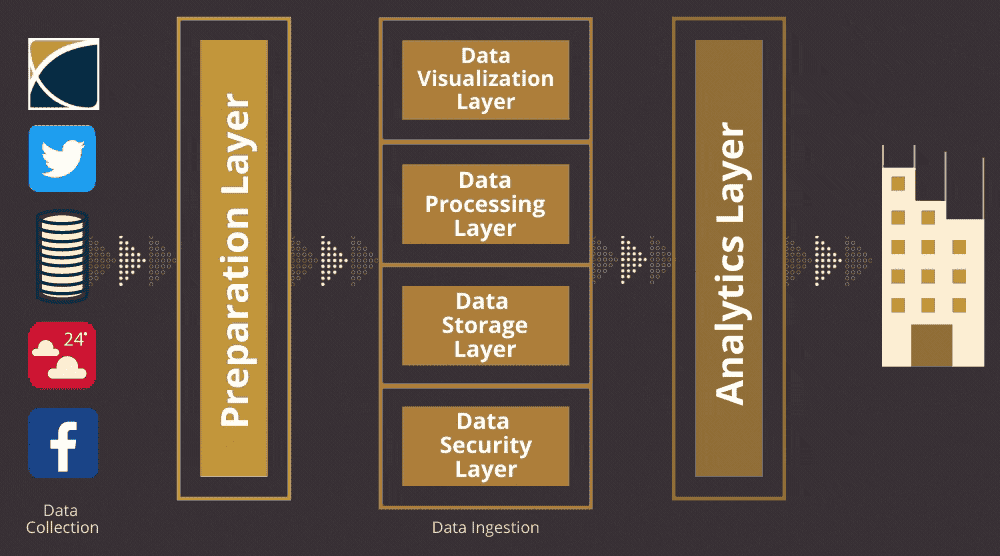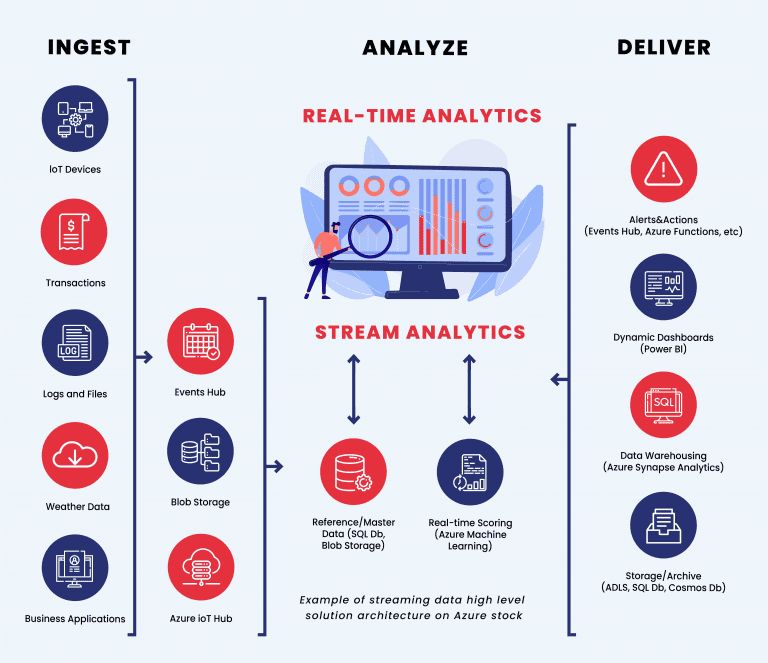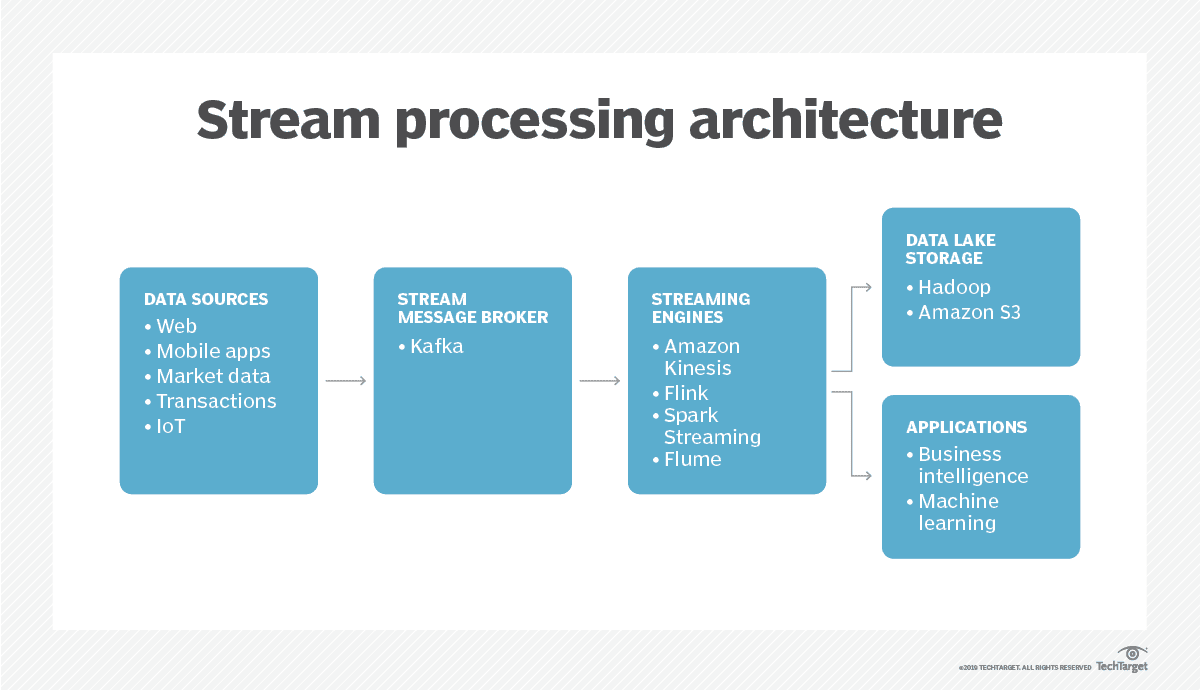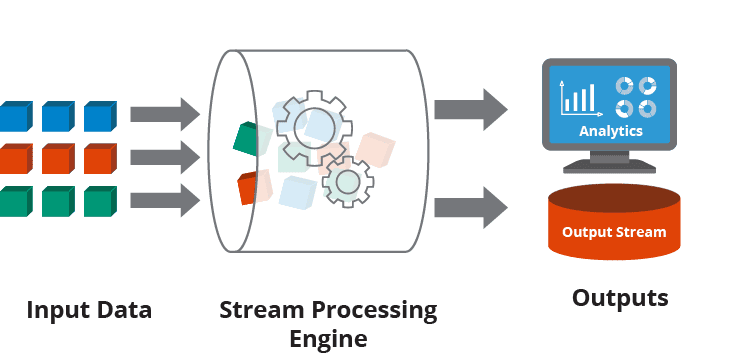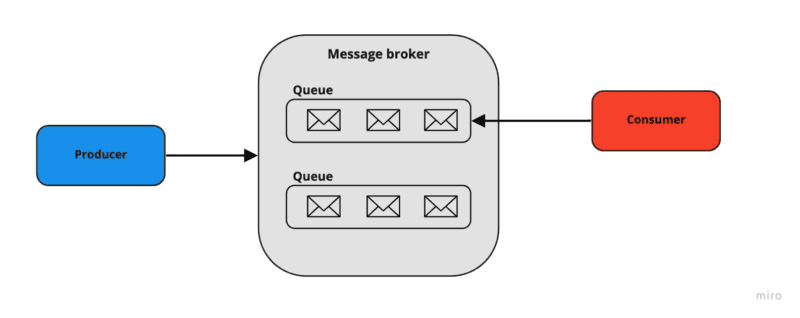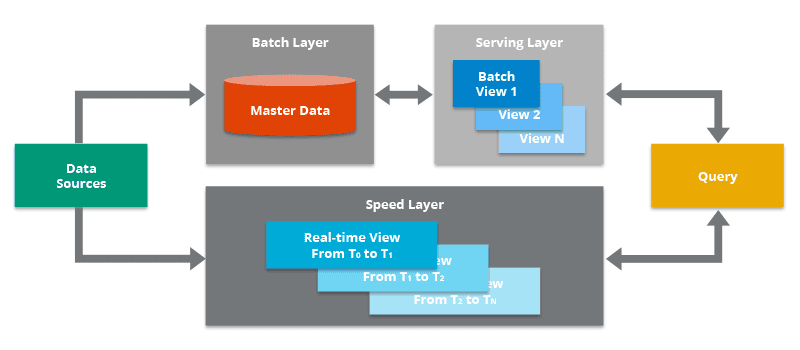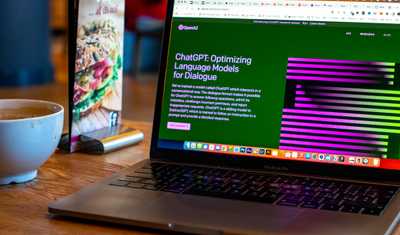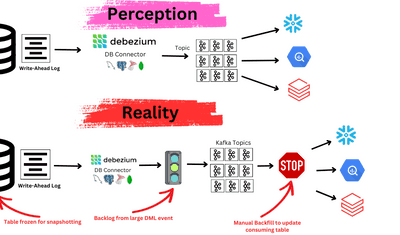
Data is no longer just growing—it’s accelerating. Businesses today generate massive volumes of data every second from sources like IoT devices, social media, and web applications. To stay competitive, organizations must process and analyze data as it’s created, rather than waiting for batches to accumulate.
Traditional data processing methods struggle to keep pace. That’s where data streaming architecture steps in—a real-time data superhero that continuously ingests, processes, and delivers data, empowering businesses to make instant, data-driven decisions.
But what exactly is data streaming architecture, and how does it work?
In this article, we’ll look into the world of data streaming architecture – from its components and processes to its diagrams and applications. We’ll explore the sources of data, how it’s ingested and processed, and who gets to consume it.
We will also guide you on how to choose the right stream processing engine, message broker, data storage service, data ingestion tool, and data visualization and reporting tool for your specific use case.
By the end of this article, you’ll have a solid understanding of data streaming architecture and its role in the data-driven world we live in.
Understanding the Data Streaming Process: Steps & Best Practices
Data streaming refers to the practice of sending, receiving, and processing information in a stream rather than in discrete batches. It involves 6 main steps:
1. Data Production
The first step in the process is when data is generated and sent from various sources such as IoT devices, web applications, or social media platforms.
- The data can be in different formats such as JSON or CSV and can have different characteristics such as structured or unstructured static or dynamic etc.
- The data producers can use various protocols and methods to send the data to the consumers such as HTTP or MQTT push or pull etc.
2. Data Ingestion
In the second step, the data is received and stored by consumers such as streaming platforms or message brokers. These data consumers can use various technologies and streaming data architectures to handle the volume, velocity, and variety of the data such as Kafka or Estuary Flow streaming pipelines, etc.
The consumers can also perform some basic operations on the data such as validation or enrichment before passing it to a stream processor.
Read more about data ingestion and integration strategies.
3. Data Processing
Next, the data is analyzed and acted on by data processing tools. These tools can use various frameworks and tools to perform complex operations on the data such as filtering, aggregation, transformation, machine learning, etc.
- Processing engines filter, aggregate, transform, and enrich data in motion, ensuring it’s ready for analytics.
- Some stream processing technologies include Apache Spark Streaming, Apache Flink, Kafka Streams, and Estuary Flow transformations.
- Processing can be fully integrated with the ingestion platform or paired with complementary tools like Flink with Kafka.
4. Streaming Data Analytics
This is the step where data is further explored and interpreted by the analysts such as business users or data scientists. The analysts can use various techniques and methods to discover patterns and trends in the data such as descriptive analytics predictive analytics prescriptive analytics etc.
- Analysts use tools like SQL, Python Notebooks, Power BI, and Looker to query and visualize streaming data.
- Outputs from this analysis can include dashboards, real-time alerts, and trend reports.
5. Data Reporting
Insights are only useful when communicated effectively. Data reporting tools take analyzed data and present it in an accessible format for stakeholders.
- Reports can be generated in various formats—documents, dashboards, email summaries, or slideshows.
- The goal is to summarize key metrics, trends, and performance indicators for informed decision-making.
Popular reporting tools include Google Data Studio, Power BI, Tableau, and Grafana.
6. Data Visualization & Decision Making
In the final step, data is displayed and acted upon by the decision-makers such as leaders or customers.
- Decision-makers use charts, maps, graphs, and dashboards to understand real-time trends.
- Interactive features like filtering, drill-downs, and alerts help users focus on relevant insights.
- Based on the insights from the visualizations, the decision-makers can make timely decisions such as optimizing processes, improving products, enhancing customer experience, etc.
What's Next?
Now that we know the basic functionality of data streaming, let’s take a look at the key components of modern stream processing infrastructure.
5 Main Components Of Data Streaming Architecture
A modern data streaming architecture refers to a collection of tools and components designed to receive and handle high-volume data streams from various origins. Streaming data is data that is continuously generated and transmitted by various devices or applications, such as IoT sensors, security logs, web clicks, etc.
A data streaming architecture enables organizations to analyze and act on a data stream in real time, rather than waiting for batch processing.
A typical data streaming architecture consists of 5 main components:
A. Stream Processing Engine
This is the core component that processes streaming data. It can perform various operations such as filtering, aggregation, transformation, enrichment, windowing, etc. A stream processing engine can also support Complex Event Processing (CEP) which is the ability to detect patterns or anomalies in streaming data and trigger actions accordingly.
Some popular stream processing tools are Apache Spark Streaming, Apache Flink, Apache Kafka Streams, etc.
How To Choose A Stream Processing Engine?
Honestly, there is no definitive answer to this question as different stream processing engines have different strengths and weaknesses and different use cases have different requirements and constraints.
However, there are some general factors that you must consider when choosing a stream processing engine. Let’s take a look at them:
- Data volume and velocity: Look at how much data you need to process per second or per minute and how fast you need to process it. Depending on their architecture and design, some stream processing engines can handle higher throughput and lower latency than others.
- Data variety and quality: The type of data you need to process is a very important factor. Depending on their schema support and data cleansing capabilities, different stream processing engines can handle data of different complexity or diverse data types.
- Processing complexity and functionality: The type and complexity of data processing needed are also very important. Some stream processing engines can support more sophisticated or flexible processing logic than others which depends on their programming model and API.
- Scalability and reliability: The level of reliability you need for your stream processing engine depends on how you plan to use it. Other factors like your company’s future plans determine how scalable the stream processing engine needs to be. Some stream processing engines can scale up or down more easily than others.
- Integration and compatibility: Stream processing engines don’t work alone. Your stream processing engine must integrate with other components of your data streaming architecture. Depending on their connectors and formats, some stream processing engines can interoperate more seamlessly than others.
B. Message Broker
Message brokers act as buffers between the data sources and the stream processing engine. It collects data from various sources, converts it to a standard message format (such as JSON or Avro), and then streams it continuously for consumption by other components.
A message broker also provides features such as scalability, fault tolerance, load balancing, partitioning, etc. Some examples of message brokers are Apache Kafka, Amazon Kinesis Streams, etc.
How To Choose A Message Broker?
With so many message brokers, selecting one can feel overwhelming. Here are factors you should consider when selecting a message broker for your data streaming architecture.
- Broker scale: With an ever-increasing amount of messages sent every second, it’s important to choose a message broker that can handle your data without sacrificing performance or reliability.
- Data persistency: When looking for a message broker, you want to make sure it can store your messages securely and reliably. Whether it’s a disk or memory-based storage, having the ability to recover data in case of unexpected failures gives you peace of mind that your important information won’t be lost.
- Integration and compatibility: It is very important to check how well your selected message broker integrates with other components of your data streaming architecture. Always choose a message broker that can interoperate seamlessly with your chosen components and supports common formats and protocols.
C. Data Storage
This component stores the processed or raw streaming data for later use. Data storage can be either persistent or ephemeral, relational or non-relational, structured or unstructured, etc. Because of the large amount and diverse format of event streams, many organizations opt to store their streaming event data in cloud object stores as an operational data lake. A standard method of loading data into the data storage is using ETL pipelines.
Some examples of data storage systems are Amazon S3, Hadoop Distributed File System (HDFS), Apache Cassandra, Elasticsearch, etc.
Read more about different types of data storage systems such as databases, data warehouses, and data lakes here.
How To Choose A Data Storage Service?
There are various factors that you must consider when deciding on a data storage service. Some of these include:
- Data volume and velocity: When it comes to data storage, you need a service that can keep up with your needs – without sacrificing performance or reliability. How much do you have to store and how quickly must it be accessed? Your selection should meet both of these criteria for the best results.
- Data variety and quality: It pays to choose a storage service that can accommodate your data type, and format, as well as offer features like compression for smoother operation. What sort of data are you looking to store? How organized and consistent is it? Are there any issues with quality or integrity? Plus encryption and deduplication mean improved security – so make sure it’s on the table.
- Data access and functionality: What kind of access do you need to your data? Do you just want basic read/write operations or something more intricate like queries and analytics? If it’s the latter, a batch processing system or real-time might be necessary. You’ll have to find a service that can provide whatever your required pattern is as well as features such as indexing, partitioning, and caching – all these extras could take up any slack in functionality.
- Integration and compatibility: Pick something capable of smooth integration and compatibility across different components, like message brokers to data stream processing engines. Plus, it should support common formats/protocols for optimal performance.
D. Data Ingestion Layer
The data ingestion layer is a crucial part that collects data from various sources and transfers it to a data storage system for further data manipulation or analysis. This layer is responsible for processing different types of data, including structured, unstructured, or semi-structured, and formats like CSV, JSON, or XML. It is also responsible for ensuring that the data is accurate, secure, and consistent.
Some examples of data ingestion tools are Apache Flume, Logstash, Amazon Kinesis Firehose, etc.
How To Choose A Data Ingestion Tool?
There are many tools and technologies available in the market that can help you implement your desired data ingestion layer, such as Apache Flume, Apache Kafka, Azure Data Factory, etc.
Here are some factors that you can consider when selecting a tool or technology for your data ingestion layer:
- Data source and destination compatibility: When searching for the right data ingestion tool, make sure it can easily link up with your data sources and destinations. To get this done without a hitch, double-check if there are any connectors or adapters provided along with the tech. These will allow everything to come together quickly and seamlessly.
- Data transformation capability: When selecting a tool or technology for data transformation, it is important to consider whether it supports your specific logic. Check if it offers pre-built functions or libraries for common transformations, or if it allows you to write your custom code for more complex transformations. Your chosen tool or technology should align with your desired data transformation logic to ensure smooth and efficient data processing.
- Scalability and reliability: It is important to consider its scalability and reliability when selecting your data ingestion tool. Consider if it can handle the amount of data you anticipate without affecting its performance or dependability. Check if it offers features like parallelism, partitioning, or fault tolerance to ensure it can scale and remain dependable.
📌 An Alternative to Multiple Tools?
While you can use dedicated data ingestion tools such as Flume or Kafka, a better option would be to use a tool like Estuary Flow that combines multiple components of streaming architecture. It includes data ingestion, stream processing, and message broker; and it contains data-lake-style storage in the cloud.
Estuary Flow supports a wide range of streaming data sources and formats so you can easily ingest and analyze data from social media feeds, IoT sensors, clickstream data, databases, and file systems.
This means you can get access to insights from your data sources faster than ever before. Whether you need to run a historic analysis or react quickly to changes, our stream processing engines will provide you with the necessary support.
And the best part?
You don’t need to be a coding expert to use Estuary Flow. Our powerful no-code solution makes it easy for organizations to create and manage data pipelines so you can focus on getting insights from your data instead of wrestling with code.
E. Data Visualization & Reporting Tools
Data components that provide a user interface for exploring and analyzing streaming data. They can also generate reports or dashboards based on predefined metrics or queries. These components work together to form a complete data streaming architecture that can handle various types of streaming data and deliver real-time insights.
Some examples of data visualization and reporting tools are Grafana, Kibana, Tableau, Power BI, etc.
How To Choose A Data Visualization & Reporting Tools For Your Data Streaming Architecture
Here are some factors to consider when choosing data visualization and reporting tools for your data streaming architecture.
- Type and volume of data you want to stream: When choosing data visualization and reporting tools, you might need different tools for different types of data, such as structured or unstructured data, and for different formats, such as JSON or CSV.
- Latency and reliability requirements: If you’re looking to analyze data quickly and with precision, check whether the tools match your latency and reliability requirements.
- Scalability and performance requirements: Select data visualization and reporting tools that can adapt and scale regardless of how much your input increases or decreases.
- Features and functionality of the tools: If you’re trying to make the most of your data, you must select tools with features catered specifically to what you need. These might include filtering abilities and interactive visualization options along with alerts for collaboration purposes.
Now that we’ve covered the five key components of a data streaming architecture, the next step is understanding how they work together in real-world systems.
Data Streaming Architecture Diagrams
Data streaming architecture is a powerful way to unlock insights and make real-time decisions from continuous streams of incoming data. This innovative setup includes three key components: data sources that provide the raw information, pipelines for processing it all in an orderly manner, and finally applications or services consuming the processed results.
A well-structured data streaming architecture consists of three main components:
- Data Sources – The origin points of raw data.
- Data Pipelines – The systems that ingest, transform, and distribute data.
- Data Consumers – The applications and users that utilize processed data.
When these components work together, businesses can track important trends as they happen, rather than waiting for batch processing cycles.
1. Data Sources – The Lifeblood of Streaming Pipelines
Data sources continuously generate and push event data into the system. These sources can be structured, semi-structured, or unstructured and vary based on the application.
- Common Data Sources:
- IoT devices – Smart sensors, industrial equipment, wearable tech.
- Web applications – User interactions, clickstreams, event logs.
- Social media platforms – Real-time comments, shares, and likes.
- Business systems – CRM, ERP, transactional databases.
- Common Data Ingestion Methods:
- Push mechanisms (event-driven updates) – MQTT, WebSockets, Kafka Producers.
- Pull mechanisms (periodic fetching) – REST APIs, HTTP polling, database CDC (Change Data Capture).
2. Data Pipelines – The Engine of Streaming Data Processing
A data pipeline is a framework that allows businesses to collect, transform, and distribute streaming data efficiently. These systems ingest high-velocity data from various sources, ensuring scalability and fault tolerance while maintaining data integrity.
- Core Functions of Data Pipelines:
- Ingestion – Receives raw event data from multiple sources.
- Transformation – Cleans, enriches, and structures data for consumption.
- Storage & Routing – Sends processed data to storage layers or analytics engines.
- Popular Data Pipeline Tools:
- Apache Kafka – High-throughput messaging system.
- Apache Flink – Low-latency stream processing.
- Estuary Flow – Real-time streaming pipeline with built-in transformations.
3. Data Consumers – Using Processed Data for Insights & Decision-Making
Once the data has been processed, data consumers extract value from it. Consumers can be business applications, analytics dashboards, AI models, or decision-makers looking to act on fresh insights.
- Types of Data Consumers:
- Analytics tools – Power BI, Tableau, Grafana for dashboards & visualizations.
- Business intelligence systems – Real-time reporting for performance tracking.
- AI & Machine Learning models – Predictive analytics & automated decision-making.
- Analytical Techniques Used:
- Descriptive Analytics – What happened? (trend analysis, KPI tracking)
- Predictive Analytics – What will happen next? (forecasting models)
- Prescriptive Analytics – What actions should be taken? (automated recommendations)
With such information at their fingertips, the users can analyze it further through descriptive analysis which examines trends in historical data to predict what may happen next. Additionally, others choose to utilize predictive technology as well as prescription tactics, both crucial aspects of any business decision-making process.
Modern Streaming Data Architecture Models
There are many ways to design and implement a data streaming architecture depending on your needs and goals. Here are some examples of a modern streaming data architecture:
1. Lambda Architecture
This is a hybrid architecture that uses two layers: a historical layer utilizing traditional technologies like Spark, then another for near-real time with quickly responding streaming tools such as Kafka or Storm.
These are unified together in an extra serving layer for optimal accuracy, scalability, and fault tolerance – though this complexity does come at some cost when it comes to latency and maintenance needs.
2. Kappa Architecture
This is a simplified approach that uses only stream processing for both historical and real-time data. It uses one layer: a stream layer that processes all the incoming data using stream technologies such as Kafka Streams or Flink.
The processed data is stored in queryable storage that supports both batch and stream queries. This approach not only offers low latency, simplicity, and consistency but also requires high performance, reliability, and idempotency.
Choosing the Right Data Streaming Architecture
Both architectures have their strengths and trade-offs. Your choice will depend on factors such as scalability, latency needs, and system complexity. Here’s how they compare:
| Feature | Lambda Architecture | Kappa Architecture |
|---|---|---|
| Processing Approach | Batch + Streaming | Streaming-Only |
| Speed | Moderate | Fast (Low-Latency) |
| Complexity | High | Lower |
| Use Cases | Financial reporting, large-scale data aggregation | IoT analytics, event-driven applications |
Conclusion
Data streaming architecture has become an essential component in the world of data processing and analysis. By utilizing streaming architecture, organizations can process streaming data in real-time to make informed decisions and take immediate action.
As data volume, variety, and velocity continue to grow, traditional batch processing will struggle to keep up. Organizations that embrace low-latency, event-driven architectures will be better positioned to adapt to market changes, improve customer experiences, and unlock new insights instantly.
Ready to experience the power of real-time data streaming? 🚀
With Estuary Flow, you can:
✅ Ingest, process, and deliver streaming data—all in one platform.
✅ Eliminate the complexity of managing multiple tools.
✅ Get insights from your data instantly, without writing complex code.
Start processing streaming data today—no setup required! Sign up for a free trial of Estuary Flow and see the difference.

About the author
With over 15 years in data engineering, a seasoned expert in driving growth for early-stage data companies, focusing on strategies that attract customers and users. Extensive writing provides insights to help companies scale efficiently and effectively in an evolving data landscape.

